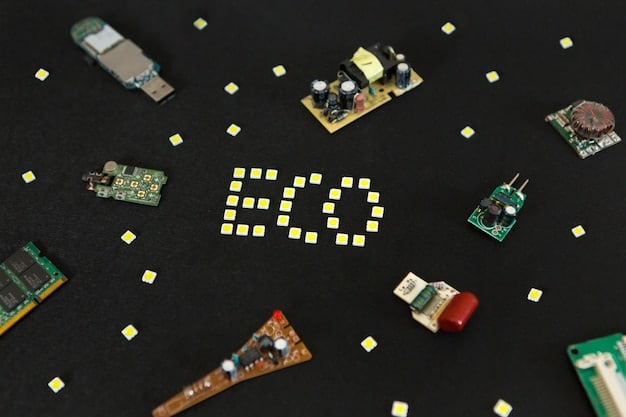DIY Smart Home Voice Assistant: Custom Commands & Actions

DIY Smart Home Voice Assistant: Integrate Custom Commands and Actions enables tech enthusiasts to personalize voice commands and automate actions, offering a unique, hands-on approach to smart home customization.
Embark on a journey of personalization and control by creating your own DIY Smart Home Voice Assistant: Integrate Custom Commands and Actions. Discover how to tailor your smart home experience today!
Understanding the Basics of Voice Assistants
Voice assistants have revolutionized how we interact with technology, from setting alarms to controlling smart home devices. Understanding the core components can empower you.
What is a Voice Assistant?
A voice assistant is a software agent that uses voice recognition, speech synthesis, and natural language processing (NLP) to provide services through voice commands.
Key Components of a Voice Assistant
Understanding these elements helps in appreciating the complexity and potential of DIY voice assistant projects.
- Voice Recognition: Converts spoken words into text.
- Natural Language Processing (NLP): Interprets the meaning of the text.
- Speech Synthesis: Converts digital text into spoken words.
- Integration with APIs: Connects the voice assistant to external services.
With a solid grasp of these basics, you are better prepared to dive into the building process, making informed decisions along the way. This foundational knowledge ensures that as you customize your voice assistant, you understand the underlying mechanics driving its functionality.
Setting Up Your Development Environment
Creating a DIY voice assistant requires setting up a suitable development environment. This ensures you have the necessary tools and libraries to streamline the coding process.

Choosing the Right Hardware
The hardware you choose significantly impacts the capabilities and scalability of your voice assistant.
Raspberry Pi is a popular choice given its versatility and extensive community support. It is a single-board computer that can run a full Linux OS.
Installing Necessary Software and Libraries
Proper setup of software and libraries is crucial for seamless development. These tools provide the functionalities needed for voice recognition, NLP, and speech synthesis.
- Python: Install Python as your primary programming language.
- SpeechRecognition Library: Use this library for converting spoken words into text.
- Pyttsx3: A text-to-speech conversion library in Python.
- APIs: Sign up to use necessary APIs such as Dialogflow or Wit.ai.
By carefully setting up your environment, you lay a reliable foundation for developing a functional and customized voice assistant. Taking the time to install and configure the software and hardware accurately will result in a more efficient and enjoyable development process.
Voice Recognition Implementation
Implementing voice recognition is a crucial aspect of building a DIY voice assistant. This process involves converting spoken words into text that your program can understand and act upon.
Configuring the Microphone
The quality of your microphone significantly impacts the accuracy of voice recognition. A good microphone captures clear audio signals, reducing noise and errors.
Writing the Recognition Code
Transforming spoken words into actionable text requires a well-structured code. This code uses libraries like SpeechRecognition to capture and process audio input.
- Initialize the Recognizer: Create an instance of the recognizer class.
- Capture Audio: Use the microphone to record audio input.
- Convert Audio to Text: Transform the audio data into text using speech recognition APIs.
Effectively implementing voice recognition is the cornerstone of creating a functional voice assistant. By ensuring accurate audio capture and precise conversion to text, you set the stage for advanced functionalities and seamless interaction.
Natural Language Processing (NLP) Integration
After converting speech to text, the next critical step is understanding the content. Natural Language Processing (NLP) enables your voice assistant to interpret the meaning and intent behind user commands, making interactions more intuitive and effective.
Choosing an NLP Service
Selecting the right NLP service is crucial for accurately understanding user input. These services provide tools and APIs to analyze text, extract intent, and identify entities.
Setting Up Intent and Entities
Defining intents and entities is fundamental to teaching your voice assistant to understand different types of commands. Intents represent actions the user wants to perform, while entities are specific details related to those actions.
- Define Intents: Create intents for common actions like setting alarms, playing music, or controlling lights.
- Define Entities: Identify key entities within each intent, such as time for alarms or song names for music.
- Training Phrases: Provide example phrases for each intent to train the NLP model.
Integrating NLP effectively enables your voice assistant to go beyond simple commands, allowing it to understand context, variations in language, and complex requests. This level of sophistication transforms a basic voice-controlled system into a versatile and intelligent assistant.
Custom Command and Action Design
The true power of a DIY voice assistant lies in its ability to execute custom commands and actions tailored to your specific needs. This section focuses on designing and implementing these unique functionalities.

Defining Custom Commands
Start by identifying the specific actions you want your voice assistant to perform. Breaking down these actions into clear, simple commands ensures smooth implementation and accurate execution.
Implementing Action Execution
Once you have defined your commands, the next step is to write the code that executes these actions. This involves integrating your commands with existing systems and APIs.
- Smart Home Integration: Connect your voice assistant to your smart home devices using APIs like IFTTT or vendor-specific SDKs.
- Service Integration: Integrate commands that interact with third-party services like weather forecasts or music streaming.
- Testing and Debugging: Thoroughly test each custom command to ensure it performs as expected and debug any errors.
Designing and implementing custom commands transforms your voice assistant from a generic tool into a personalized hub for your digital life. This level of customization not only enhances convenience but also unlocks new possibilities for automation and control.
Testing and Troubleshooting
After setting up your development environment, implementing voice recognition, integrating NLP, and designing custom commands, thorough testing and troubleshooting are essential to ensure your DIY voice assistant functions correctly and reliably. Identifying and resolving issues early on can save significant time and frustration.
Testing Voice Recognition Accuracy
Accurate voice recognition is vital for a good user experience. Test the voice recognition feature in various environments and with different users to identify potential issues.
Debugging NLP Integration
Debugging the NLP integration is crucial for ensuring your voice assistant correctly interprets user commands. Verify that intents and entities are accurately recognized and that the system responds appropriately.
- Review Training Data: Ensure your training data covers a wide range of phrases and scenarios.
- Check Intent Recognition: Use the NLP service’s testing tools to verify intent recognition accuracy.
- Handle Edge Cases: Consider and address potential edge cases and unexpected input.
A robust testing and troubleshooting process ensures your DIY voice assistant meets your functional requirements and provides a reliable user experience.
| Key Aspect | Brief Description |
|---|---|
| 🎤 Voice Recognition | Converts spoken words into text for command processing. |
| 🧠 NLP Integration | Enables the assistant to understand user intent. |
| ⚙️ Custom Commands | Tailored actions for specific needs. |
| 🛠️ Troubleshooting | Addresses issues for reliable performance. |
Frequently Asked Questions
▼
A Raspberry Pi is highly recommended due to its versatility and extensive community support. Additionally, consider a good quality microphone for accurate voice input.
▼
Popular choices include Dialogflow, Wit.ai, and Rasa. These services offer APIs and tools for intent recognition and entity extraction to understand user commands.
▼
Use APIs like IFTTT or vendor-specific SDKs (e.g., Philips Hue API) to connect your voice assistant with smart home devices. This allows you to control lights, thermostats and other appliances.
▼
Python is often the best choice due to its simplicity and extensive libraries for voice recognition (SpeechRecognition) and text-to-speech conversion (Pyttsx3). It is easy to learn and use.
▼
Ensure a high-quality microphone, reduce background noise, and train the NLP model with a wide range of phrases. Update your system regularly to improve functionality.
Conclusion
Creating a DIY Smart Home Voice Assistant: Integrate Custom Commands and Actions offers a rewarding journey into personalized technology. By combining the basics of voice recognition, NLP, and custom action design, you can create a voice assistant that caters to your specific needs. Embrace the DIY spirit and unlock the potential of your smart home today!





